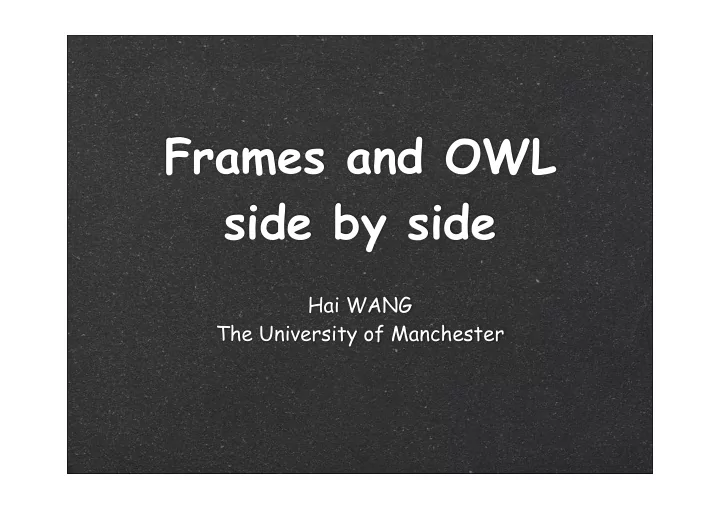

Frames and OWL side by side Hai WANG The University of Manchester
Outline Introduction Major Differences Frames or OWL? Conclusion
Introduction Exists two major ontology modeling flavors: Frames based formalisms the dominant approach to knowledge modeling e.g. Protege-Frames, Ontolingua Description Logics based formalisms Increasingly popular e.g. OWL
Introduction Exists two major ontology modeling flavors Users confuse them and make mistakes! What is the difference? What each of them CAN or CANNOT do? Which one should I choose?
Introduction Exists two major ontology modeling flavors Users confuse about them and make mistakes! Scopes DLs flavor -- OWL DL Frames flavor -- Protégé Frames
Introduction -- Frames Class A class is a set of entities A class can be an instance as well Slot Describe the properties of classes and instances Two ways to be attached to a frame: Template slot and Own slot Facet Specify constraints on allowed slot values
Introduction -- OWL Class Named Class and anonymous classes Class and Individual are disjoint Property Vocabulary comparison Frames OWL Class Class Concepts in application domains Slot Property Relations � Facet Restriction Constrain on slot/property values
Outline Motivation Background Major Differences Frames or OWL? Conclusion
Semantics difference (UNA) Unique Name Assumption : By default, different names refer to different things. Frames OWL YES NO In OWL, different names can refer to the same thing. Matthew Nick Matt matthew.horridge Matty Matthew Horridge mhorridge Handsome
Semantics difference (UNA) Example Two individuals Matthew and Nick, are the chefs for the PizzeriaDelDoge, which is an instance of the class Pizza Restaurant. Frames OWL ... ... ([PizzeriaDelDoge F ] of PizzaRestaurant F Individual (PizzeriaDelDoge (hasChef F [Matthew F ] type (PizzaRestaurant) [Nick F ]) value (hasChef Matthew) value (hasChef Nick)) AllDifferentFrom( Matthew , Nick ) PizzeriaDelDoge has EXACTLY PizzeriaDelDoge has AT LEAST TWO chefs. TWO chefs. ONE chef.
Semantics difference (Close World Vs. Open World Reasoning) Frames OWL Adopts CWR Adopts OWR If a fact is absent Something is false from the knowledge base, only if it contradicts it is assumed to be false. other information Everything is Everything is permitted until it is prohibited until it is prohibited. permitted.
Semantics difference (Close World Vs. Open World Reasoning) Example Two individuals,Matthew and Nick, are the chefs for the PizzeriaDelDoge, which is an instance of the class Pizza Restaurant. OWL Frames ... ... Individual (PizzeriaDelDoge ([PizzeriaDelDoge F ] of PizzaRestaurant F type (PizzaRestaurant) (hasChef F [Nick F ] value (hasChef Matthew) [Matthew F ]) value (hasChef Nick) AllDifferentFrom (Matthew, Nick)) Type(restriction ( hasChef allValuesFrom(oneof(Matthew, Nick)))) PizzeriaDelDoge has EXACTLY PizzeriaDelDoge has AT LEAST EXACTLY TWO TWO chefs. chefs.
Semantics difference (Single model vs. Multiple Models) OWL Frames Multiple Models Single Model For one KB, there For one KB, there could exists only one model. exist many models. Single Model Multiple Models Non-Monotonic Monotonic Can’t capture incomplete Can capture incomplete information information Less expressive and cannot support More expressive and can support negation and disjunction. negation and disjunction. Comparison between single model and multiple modes
Implications for Modeling (Assertion vs. Classification) Frames OWL All subclass relations Subclass relations can must be asserted be inferred based on the explicitly. class definition.
Implications for Modeling (Assertion vs. Classification) Example VegetarianPizza is any pizza that has only vegetables as its toppings. MushroomPizza is a pizza with only mushrooms as toppings. MushroomPizza is a VegetarianPizza. Frames OWL Class (VegetarianPizza COMPLETE ( defclass VegetarianPizza F ....) Pizza (restriction hasTopping allValuesFrom (defclass MushroomPizza F Vegetable)) (multislot hasTopping F Class (MushroomPizza partial (allowed-class Mushroom F ) Pizza restriction (hasTopping allValuesFrom Mushroom)) ( IS-A VegetarianPizza F ) ) ⇒ subClassof ( MushroomPizza,VegetarianPizza) VegetarianPizza F has only necessary definition. VegetarianPizza has a sufficient definition. Assert explicitly that MushroomPizza is a subclass of VegetarianPizza The subclass relation will be inferred.
Implications for Modeling (Constraint vs. Consistency checking) Frames OWL Constraint checking Consistency checking. All the asserted axioms Check whether slot are valid values for instances of a Check if there is a model class is valid. that satisfies all the assertions. Major statements playing different roles: Facets and property restrictions; Domains and ranges of slots and properties;
Implications for Modeling (Assertion vs. Consistency checking) Example The slot/property hasTopping has the domain as Pizza. Choc ice-cream has toppings. Frames OWL ObjectProperty (hasTopping domain Pizza) ( multislot hasTopping F ( Type instance) ( domain Pizza F )) (defclass ChocIcecream F Class (ChocIcecream partial ! (multislot hasTopping F ....) restriction (hasTopping someValuesFrom Chocolate)) ⇒ subClassof ( ChocIcecream, Pizza) All the asserted axioms are assumed It is an ERROR in Frames! to be right. Infer that ChocIcecream is a subclass of Pizza.
Implications for Modeling ( Associate of properties/slots ) Frames OWL Two Steps to add Restriction can be constrains to classes: associated with a class 1. add the slot to the directly. class. 2. associate a facet to the template slot
Expressiveness Power (Frames) Meta-modeling Classes as property values Default information and exception
Expressiveness Power (OWL) Defined classes Embedding class Definition ( anonymous classes ) Set combination on classes Characters of Properties Functional, symmetric (Allowed in Frames) Transitive (Not allowed in Frames) OWL 1.1: reflexive, irreflexive, symmetric, and anti-symmetric
Outline Motivation Background Major Differences Frames or OWL? Conclusion
Frames or OWL? -- Some Guidelines OWL Frames An application where: An application where: The open-world assumption is appropriate. The closed-world assumption is New classes have been built from the appropriate. combinations of other classes. Focuses on data acquisition on Logical consistency needs to be ensured instances. Published on the Semantic Web and Requires constraints on slot values. accessed by other applications. Meta-modeling is important Complicated class hierarchy need to be maintained.
Conclusion Motivation Background Similarities and Differences Conclusion Frames or OWL? Conclusion
Conclusion Semantic difference UNA Closed world vs Open World Assumption Single Vs. Multiple models Implication Assertion vs Classification Property association Constrain checking vs Reasoning Expressive Power Others ...
Thank You.
Recommend
More recommend